Coronavirus: School return plan 'like a jigsaw puzzle'
- Published

Head teacher Debbie Whiting set up a food bank to support families in poverty (photo taken before lockdown)
The government has told schools to reopen for certain year groups from 1 June. But what does it mean in practical terms for schools - and how are they getting ready? We spoke to one head teacher to find out.
"It's like doing a jigsaw puzzle where all the pieces are green."
That is how Debbie Whiting, head teacher of North Denes Primary School in Norfolk, describes the task in front of her - remodelling her school during a pandemic so that three classes can return next month.
"The more you look at things, the more there is to think about," she says.
Classrooms have been stripped out, new signage put up around the school and year groups divided into small "bubbles" to keep pupils away from each other and - it is hoped - minimise the risk of coronavirus spreading.
The school in Great Yarmouth already knows it will not be ready to reopen for Reception, Year 1 and Year 6 classes on 1 June, and is instead working to a deadline of 8 June.
This summer the school should have been preparing to move into its new £9m buildings, but construction delays mean all focus is now on making the existing school safe for returning pupils.
"The 1 June date might be convenient for being after half-term but it's not given us anything like the time we need to put things in place," says Mrs Whiting.
"It's really difficult. You just keep thinking, have we caught everything?"
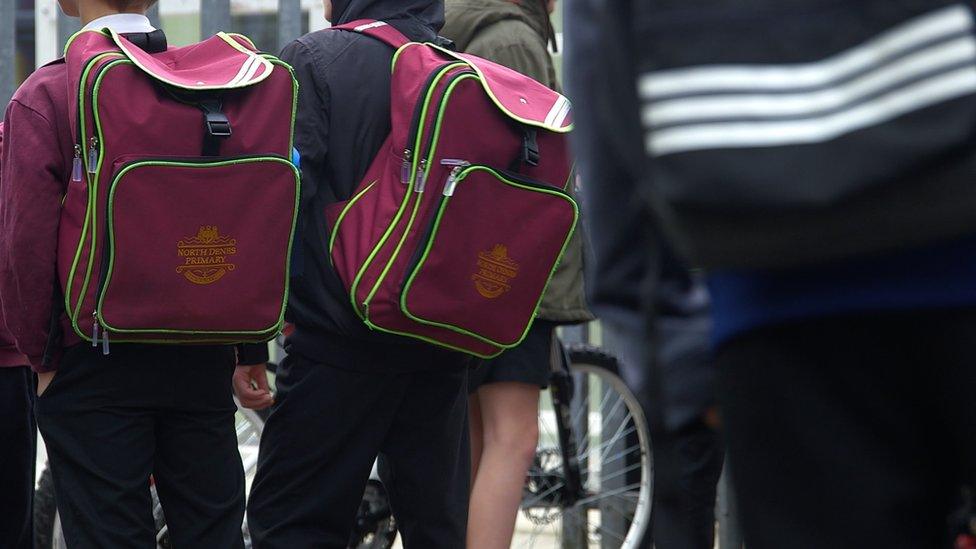
Children will have to keep their distance from friends and others in their bubble (image from before lockdown)
'Planning is tricky'
Parents have been asked whether they will send their children back - but only half have responded, making planning difficult. So far, one-third of those who have replied say their children will return.
Mrs Whiting estimates she can make her plans work if about 40% of the 180 children return. If they all came back, she would need an extra 12 classrooms at the school.
The school hopes to make social distancing as natural as possible for children by breaking classes into smaller "bubbles" of about seven pupils and two teachers. But without knowing the intentions of the other families, the plans could be useless.
Mrs Whiting has left the decision up to parents, but wrote to them recently to warn them "school will be a very different place".
"Until we have those numbers, planning to keep everyone safe in bubbles is really tricky," she said.
"My concern is that they've heard that schools are reopening and on 1 June they just arrive."
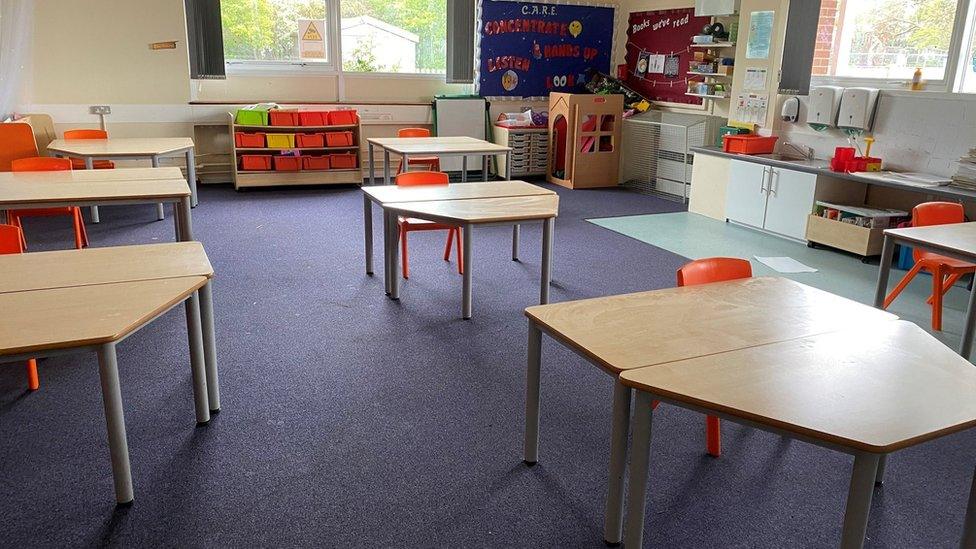
No more than eight people will be in each teaching bubble
Life in a bubble
For the rest of term, all school life will take place within the bubbles.
In those groups pupils will learn, eat and play, with each bubble using a nominated classroom and set of toilets to prevent cross-infection.
Children will not be allowed to take bags to school, and will work in a new exercise book and their teacher will not take them home to mark.
Uniform policy will be scrapped as children will need to wear clean clothes every day "and many will have outgrown it anyway".
"If they've got different clothes on every day you'll know that they've actually changed," said Mrs Whiting.
The school has gained experience from teaching the children of key workers over the past weeks, and the numbers have steadily risen from eight pupils to 20.
"Parents will expect us to social-distance their children, and we intend to do that," says Mrs Whiting.
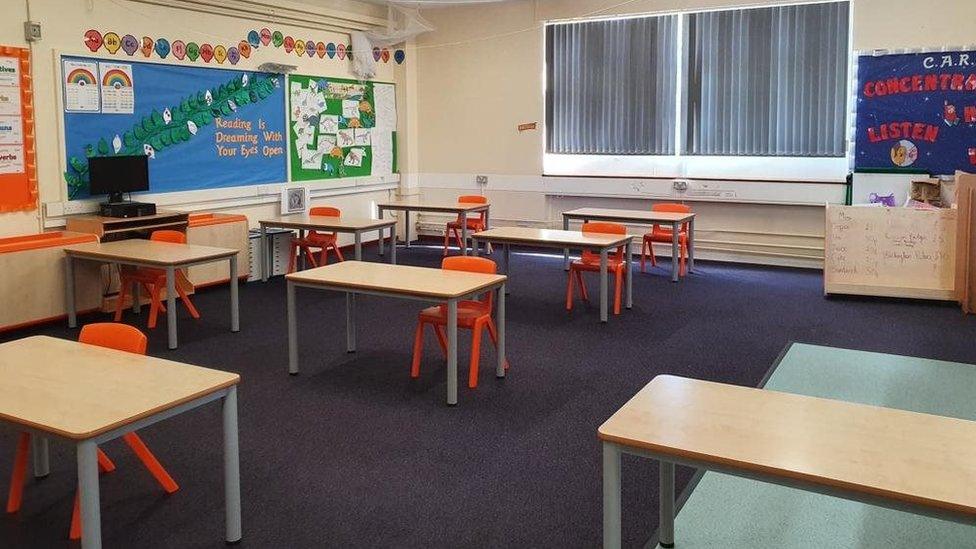
The Year 1 classroom has been decluttered for socially-distanced teaching
The school day
The school day will be re-organised, with staggered starts and a lunchtime finish once children have been given their food.
In the morning, children in each bubble will arrive at 15-minute intervals, and line up in the playground two metres (6ft 6ins) apart before being led into their classrooms.
Only one parent will be allowed to drop off and collect each child, with no gathering by the school gates, though Mrs Whiting acknowledges getting several children to school at different times is "likely to cause problems" in single-parent households.
Bubbles will be kept separate at break times and when they are given lunch, with each being given their own area of the playground to use.
Even before coronavirus, the school was without its kitchen because of building works, and could only use half of its main hall.
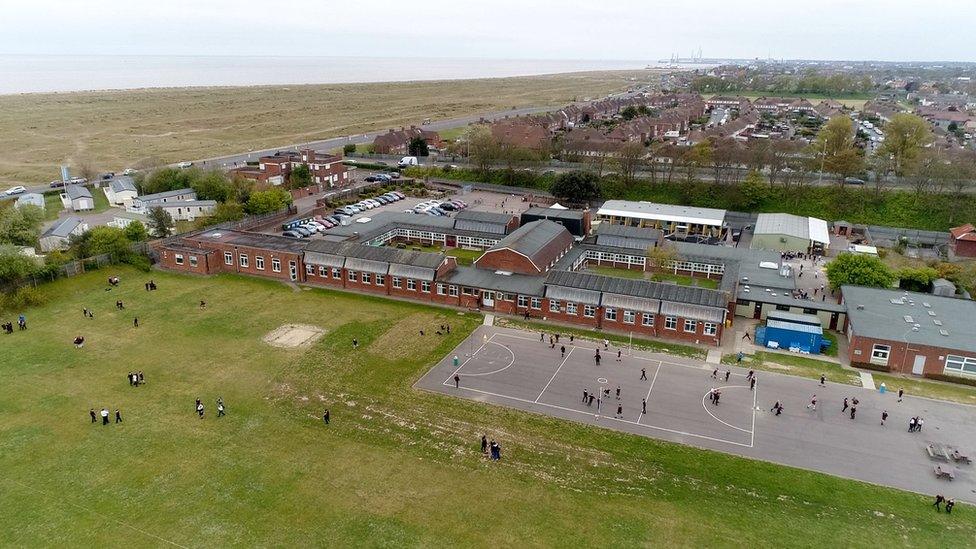
North Denes Primary serves one of the most deprived boroughs in the country
Building in safety
Pupils' movements around the school will be restricted mainly to their bubbles, but the way they use the communal areas will change.
Each year will have a separate entrance to the buildings, and school corridors will operate a one-way system so people can maintain their distance.
Doors will be left propped open and handles cleaned regularly.
"It's about controlling all movement," says Mrs Whiting.
"We also started careful hand washing before the lockdown and the children have been pretty good at that."
Hand dryers in the toilets have been switched off on official advice, and replaced with paper towels, while the school has ordered pedal bins for every classroom so that PPE - which will be used for first aid or personal care - can be disposed of safely and without contact.
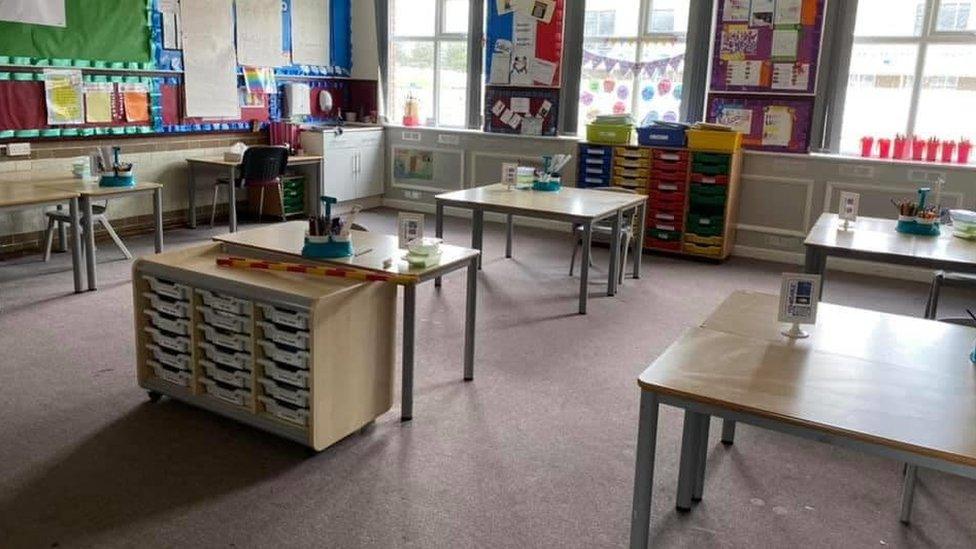
Pupils will be forbidden from sharing pens or pencils to stop cross-contamination
Different class
Classrooms will also look different, with the need for distancing reducing capacity to about eight desks.
All rooms have now been decluttered and non-essential items removed, filling the school's storage spaces.
In the younger age groups' classrooms, soft furnishings, rugs and toys have been removed - anything remaining will have to be washed at the end of each day.
Cleaning routines have been stepped up and surfaces will be disinfected regularly.
Pupils will be asked to bring their own stationery, and forbidden from sharing.
In a letter to parents, Mrs Whiting had previously warned "there is no such thing as social distancing in a school - we can try but we certainly cannot guarantee it".

LOCKDOWN UPDATE: What's changing, where?
EXERCISE: What are the guidelines on getting out?
THE R NUMBER: What it means and why it matters
AIR TRAVELLERS: The new quarantine rules
LOOK-UP TOOL: How many cases in your area?

Responsibility
The logistics of preparing the school come on top of the everyday challenges of leading a school in one of the most deprived boroughs in the country.
"The government line is to get children in school so that they don't fall behind, and in disadvantaged areas that is important," says Mrs Whiting.
"But a lot of those who want to return are not those who are in that group."
The Department for Education says it wants children back in schools "for their education and wellbeing", and the phased return is based on scientific and medical advice.
For head teachers, the last few weeks have been "wearing", says Mrs Whiting, as they juggle pressures from government, parents who want their children to be kept at home, and those who want them back at school.
Underpinning all the preparations, her focus has been on keeping the children as safe as possible.
"This is something I've never ever had to deal with," she said. "And you do wonder what happens if someone gets it and, heaven forbid, there's a fatality?
"But I can't hold myself responsible for that, because I'm not the one who is asking them to come back."
- Published23 February 2022

- Published15 May 2020

- Published7 May 2019
